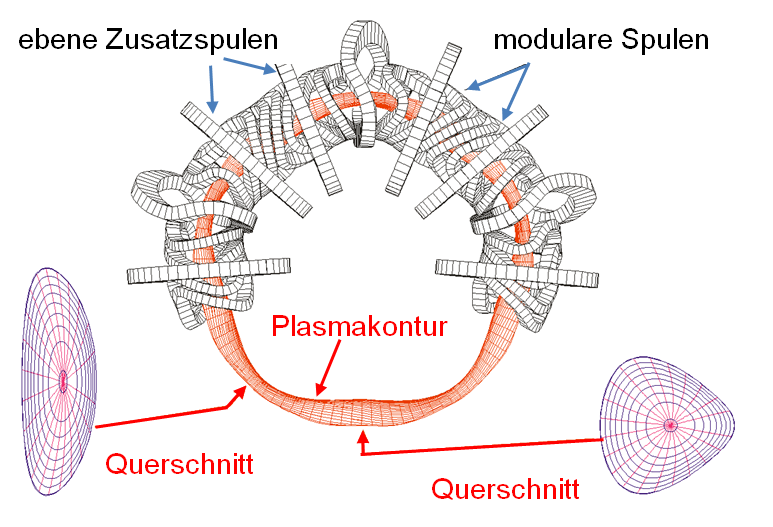|
Wendelstein 7-AS
Wendelstein 7-AS (abbreviated W7-AS, for "Advanced Stellarator") was an experimental stellarator which was in operation from 1988 to 2002 by the Max Planck Institute for Plasma Physics (IPP) in Garching bei München, Garching. It was the first of a new class of advanced stellarators with modular coils, designed with the goal of developing a nuclear fusion reactor to generate electricity. The experiment was succeeded by Wendelstein 7-X, which began construction in Greifswald in 2002, was completed in 2014 and started operation in December 2015. The goal of its successor is to investigate the suitability of components designed for a future fusion reactor. Experimental design Wendelstein 7-AS was a stellarator, a device which generates the magnetic fields necessary for the confinement of a hot hydrogen Plasma (physics), plasma via current-carrying coils outside the plasma. They are potential candidates for fusion reactors designed for continuous operation as the current exclusiv ... [...More Info...] [...Related Items...] OR: [Wikipedia] [Google] [Baidu] |
Stellarator
A stellarator confines Plasma (physics), plasma using external magnets. Scientists aim to use stellarators to generate fusion power. It is one of many types of magnetic confinement fusion devices. The name "stellarator" refers to stars because fusion mostly occurs in stars such as the Sun. It is one of the earliest human-designed fusion power devices. The stellarator was invented by American scientist Lyman Spitzer in 1951. Much of its early development was carried out by Spitzer's team at what became the Princeton Plasma Physics Laboratory (PPPL). Spitzer's Model A began operation in 1953 and demonstrated plasma confinement. Larger models followed, but demonstrated poor performance, losing plasma at rates far worse than theoretical predictions. By the early 1960s, hopes of producing a commercial machine faded, and attention turned to studying fundamental theory. By the mid-1960s, Spitzer was convinced that the stellarator was matching the Bohm diffusion rate, which suggested i ... [...More Info...] [...Related Items...] OR: [Wikipedia] [Google] [Baidu] |
Tokamak
A tokamak (; ) is a device which uses a powerful magnetic field generated by external magnets to confine plasma (physics), plasma in the shape of an axially symmetrical torus. The tokamak is one of several types of magnetic confinement fusion, magnetic confinement devices being developed to produce controlled thermonuclear fusion power. The tokamak concept is currently one of the leading candidates for a practical fusion reactor for providing minimally polluting electrical power. The proposal to use controlled thermonuclear fusion for industrial purposes and a specific scheme using thermal insulation of high-temperature plasma by an electric field was first formulated by the Soviet physicist Oleg Lavrentiev in a mid-1950 paper. In 1951, Andrei Sakharov and Igor Tamm modified the scheme by proposing a theoretical basis for a thermonuclear reactor, where the plasma would have the shape of a torus and be held by a magnetic field. The first tokamak was built in the Soviet Union ... [...More Info...] [...Related Items...] OR: [Wikipedia] [Google] [Baidu] |
H-mode
In plasma physics and magnetic confinement fusion, the high-confinement mode (H-mode) is a phenomenon observed in toroidal fusion plasmas such as tokamaks. In general, plasma energy confinement degrades as the applied heating power is increased. Above a certain characteristic power threshold, the plasma transitions from L-(low-confinement) to H-mode regime, where the particle and energy confinement is significantly enhanced. The H-mode was discovered by Friedrich Wagner and team in 1982 on the ASDEX diverted tokamak.How Fritz Wagner "discovered" the H-Mode It has since been reproduced in all major toroidal confinement devices, and is foreseen to be the standard operational scenario of many future reactors, such as |
Contamination
Contamination is the presence of a constituent, impurity, or some other undesirable element that renders something unsuitable, unfit or harmful for the physical body, natural environment, workplace, etc. Types of contamination Within the sciences, the word "contamination" can take on a variety of subtle differences in meaning, whether the contaminant is a solid or a liquid, as well as the variance of environment the contaminant is found to be in. A contaminant may even be more abstract, as in the case of an unwanted energy source that may interfere with a process. The following represent examples of different types of contamination based on these and other variances. Chemical contamination In chemistry, the term "contamination" usually describes a single constituent, but in specialized fields the term can also mean chemical mixtures, even up to the level of cellular materials. All chemicals contain some level of impurity. Contamination may be recognized or not and may become a ... [...More Info...] [...Related Items...] OR: [Wikipedia] [Google] [Baidu] |
Plasma Instabilities
In plasma physics, plasma stability concerns the stability properties of a plasma in equilibrium and its behavior under small perturbations. The stability of the system determines if the perturbations will grow, oscillate, or be damped out. It is an important consideration in topics such as nuclear fusion and astrophysical plasma. In many cases, a plasma can be treated as a fluid and analyzed with the theory of magnetohydrodynamics (MHD). MHD stability is necessary for stable operation of magnetic confinement fusion devices and places certain operational limits. The beta limit, for example, sets the maximum achievable plasma beta in tokamaks. On the other hand, small-scale plasma instabilities (typically described by kinetic theory), such as the drift wave instability, are believed to be the driving mechanism of turbulent transport in tokamaks, which leads to high rate of particle and energy transport across the confining magnetic fields. Plasma instabilities described by ... [...More Info...] [...Related Items...] OR: [Wikipedia] [Google] [Baidu] |
Electron
The electron (, or in nuclear reactions) is a subatomic particle with a negative one elementary charge, elementary electric charge. It is a fundamental particle that comprises the ordinary matter that makes up the universe, along with up quark, up and down quark, down quarks. Electrons are extremely lightweight particles that orbit the positively charged atomic nucleus, nucleus of atoms. Their negative charge is balanced by the positive charge of protons in the nucleus, giving atoms their overall electric charge#Charge neutrality, neutral charge. Ordinary matter is composed of atoms, each consisting of a positively charged nucleus surrounded by a number of orbiting electrons equal to the number of protons. The configuration and energy levels of these orbiting electrons determine the chemical properties of an atom. Electrons are bound to the nucleus to different degrees. The outermost or valence electron, valence electrons are the least tightly bound and are responsible for th ... [...More Info...] [...Related Items...] OR: [Wikipedia] [Google] [Baidu] |
Program Optimization
In computer science, program optimization, code optimization, or software optimization is the process of modifying a software system to make some aspect of it work more efficiently or use fewer resources. In general, a computer program may be optimized so that it executes more rapidly, or to make it capable of operating with less memory storage or other resources, or draw less power. Overview Although the term "optimization" is derived from "optimum", achieving a truly optimal system is rare in practice, which is referred to as superoptimization. Optimization typically focuses on improving a system with respect to a specific quality metric rather than making it universally optimal. This often leads to trade-offs, where enhancing one metric may come at the expense of another. One popular example is space-time tradeoff, reducing a program’s execution time by increasing its memory consumption. Conversely, in scenarios where memory is limited, engineers might prioritize a slower ... [...More Info...] [...Related Items...] OR: [Wikipedia] [Google] [Baidu] |
Computing Power
In computing, computer performance is the amount of useful work accomplished by a computer system. Outside of specific contexts, computer performance is estimated in terms of accuracy, efficiency and speed of executing computer program instructions. When it comes to high computer performance, one or more of the following factors might be involved: * Short Response time (technology), response time for a given piece of work. * High throughput (rate of processing work tasks). * Low utilization of computing resources. ** Fast (or highly compact) data compression and decompression. * High availability of the computing system or application. * High Bandwidth (computing), bandwidth. * Short data transmission time. Technical and non-technical definitions The performance of any computer system can be evaluated in measurable, technical terms, using one or more of the metrics listed above. This way the performance can be * Compared relative to other systems or the same system before/after ... [...More Info...] [...Related Items...] OR: [Wikipedia] [Google] [Baidu] |
Degrees Of Freedom
In many scientific fields, the degrees of freedom of a system is the number of parameters of the system that may vary independently. For example, a point in the plane has two degrees of freedom for translation: its two coordinates; a non-infinitesimal object on the plane might have additional degrees of freedoms related to its orientation. In mathematics, this notion is formalized as the dimension of a manifold or an algebraic variety Algebraic varieties are the central objects of study in algebraic geometry, a sub-field of mathematics. Classically, an algebraic variety is defined as the solution set, set of solutions of a system of polynomial equations over the real number, .... When ''degrees of freedom'' is used instead of ''dimension'', this usually means that the manifold or variety that models the system is only implicitly defined. See: * Degrees of freedom (mechanics), number of independent motions that are allowed to the body or, in case of a mechanism made of seve ... [...More Info...] [...Related Items...] OR: [Wikipedia] [Google] [Baidu] |
Modularity
Modularity is the degree to which a system's components may be separated and recombined, often with the benefit of flexibility and variety in use. The concept of modularity is used primarily to reduce complexity by breaking a system into varying degrees of interdependence and independence across and "hide the complexity of each part behind an abstraction and interface". However, the concept of modularity can be extended to multiple disciplines, each with their own nuances. Despite these nuances, consistent themes concerning modular systems can be identified. Composability is one of the tenets of functional programming. This makes functional programs modular. Contextual nuances The meaning of the word "modularity" can vary somewhat based on context. The following are contextual examples of modularity across several fields of science, technology, industry, and culture: Science *In biology, modularity recognizes that organisms or metabolic pathways are composed of modules. *I ... [...More Info...] [...Related Items...] OR: [Wikipedia] [Google] [Baidu] |




